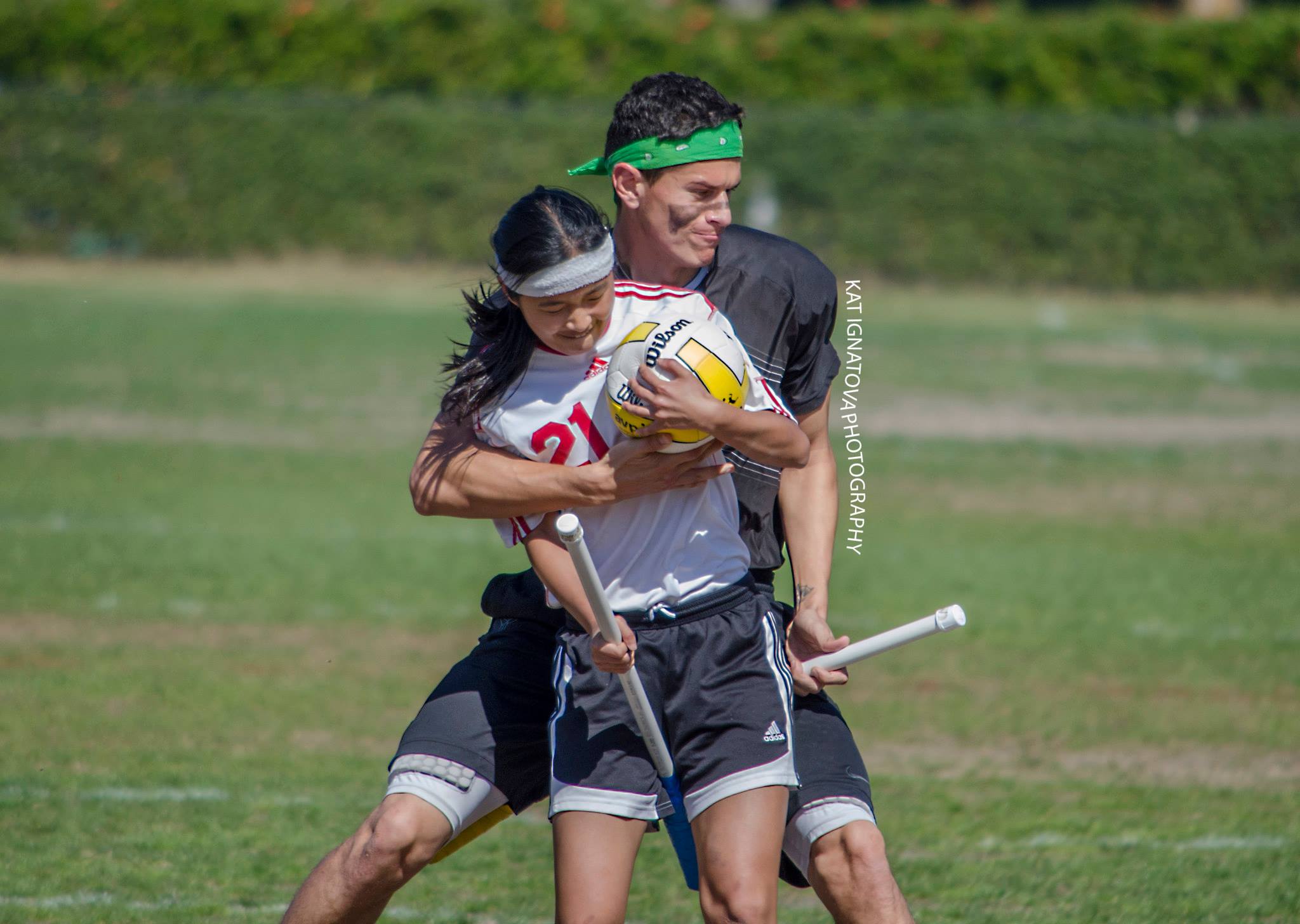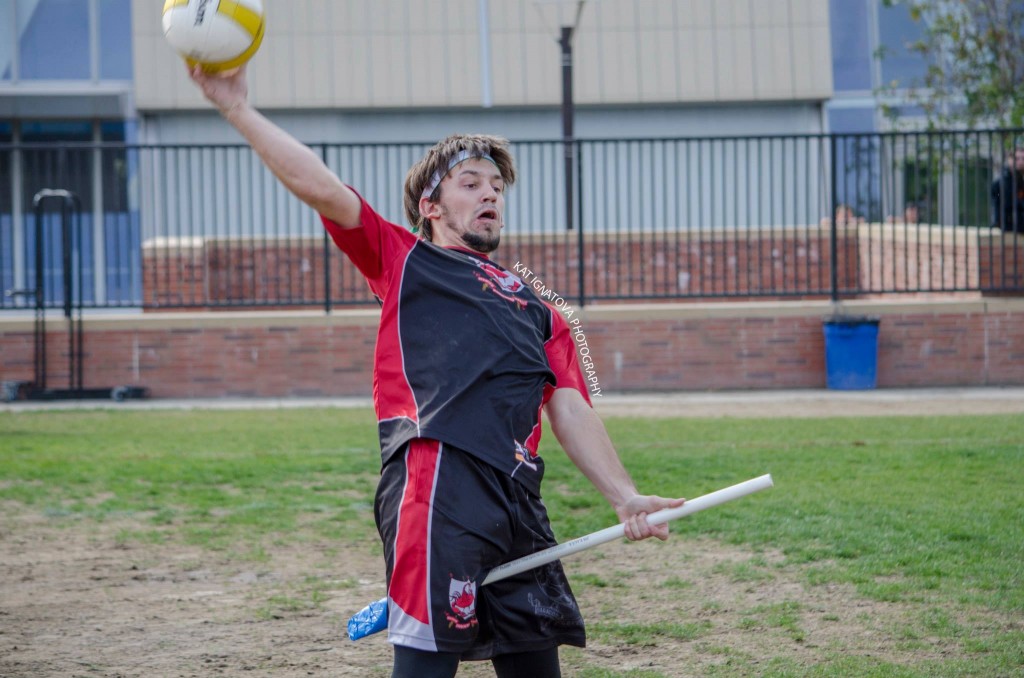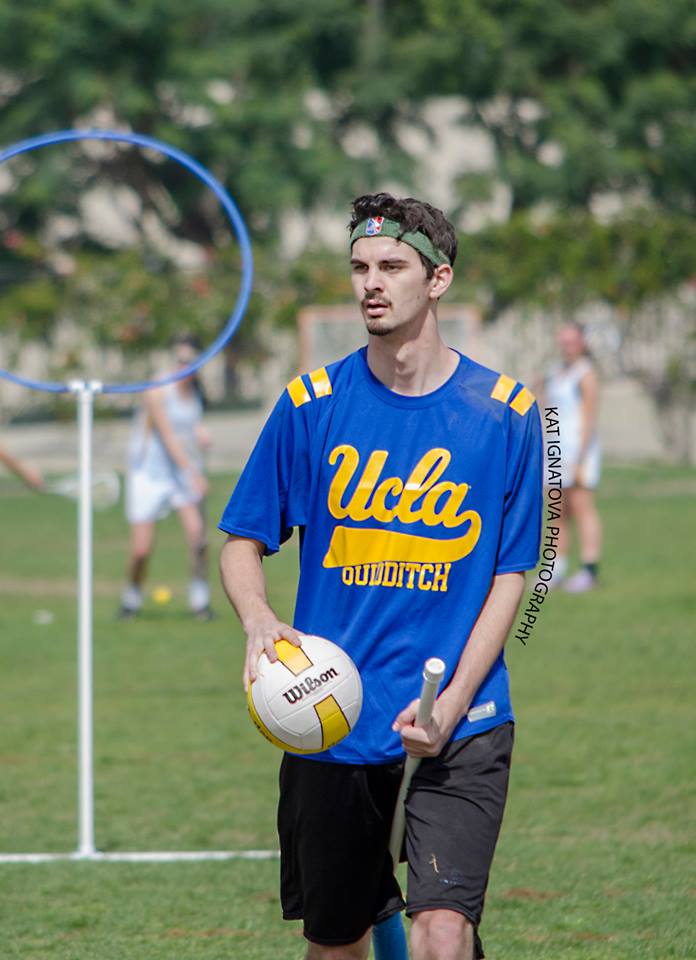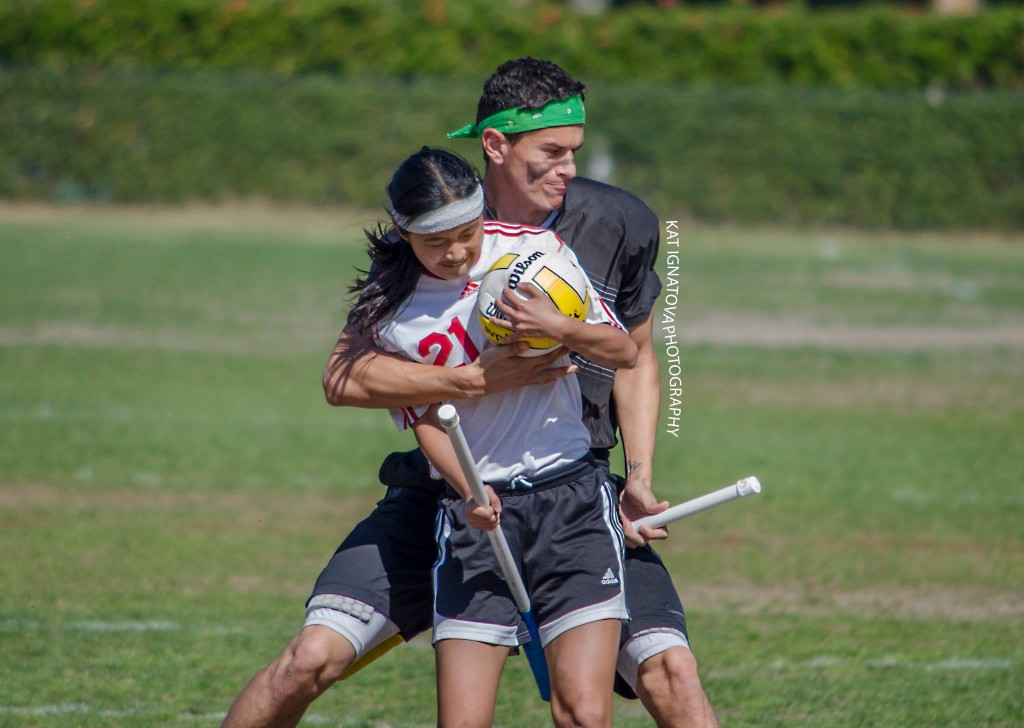- Rule, Britannia, no more?
- Unpopular Opinions: US Quadball Cup 2023
- Proven Contenders: University of Virginia
- Proven Contenders: Rutgers University
- Proven Contenders: University of Michigan
- Proven Contenders: Creighton University
- Different Perspectives: A Look Inside USA Ultimate
- Antwerp QC, Much of Belgian Core, Leaves Competitive Quidditch
He Who Hesitates is Poor: A West Region Power Rankings
- Updated: March 11, 2014

Surprising a grand total of zero people, the Lost Boys Quidditch Club rolled through the Gold Medal invitational, defeating UCLA and taking the tournament in a surprisingly close match, 150*-60.
While missing some key players – most notably beater Chris Seto – the Lost Boys dominated throughout, looking even remotely vulnerable only at two occasions in the tournament: once as a University of British Columbia squad remained within snitch range as the snitch returned to the pitch, and once during the finals when UCLA managed to get within 40 with a Lost Boys player still serving out a red card. But, in all cases, the Lost Boys pushed back, eliminating any doubt, as though any remained, of who the best team in the West is.
But the much more interesting takeaway from Gold Medal is the hotly-contested race for the title of second-best team in the West. A large crop of challengers have emerged, and this large-scale tournament gives us a great opportunity to evaluate the state of the Western Region as we approach Myrtle Beach. Which teams are doomed to early exit, and who could surprise for a late day two push?
In this exercise, I’ll be mostly grouping the teams into tiers. Only teams that are qualified for world cup and have not declined attendance will be included here. Tiers are sorted alphabetically, with some help from my good friend, Mel Brooks.
“I’m in pain and I’m wet and I’m still hysterical!”
San Jose State University: Thanks to University of Arizona dropping out, one of the oldest teams in the Western region picks up a bid. While San Jose is actually the oldest team in the Bay Area – predating both Silicon Valley and Cal by a bit – they’ve probably had the lowest profile of any of them, never having attended a World Cup or traveling for a tournament that isn’t Western Cup. And while the ceiling for this team feels pretty low, this team still has a shot to steal a win or two at World Cup, but only if they right players end up making the trip.
I’d be shocked if the team managed makes bracket play, and surprised if they even pull out a win, but this won’t be the worst team at World Cup, and regardless of how well they do, experience against the highest level of competition should help the team going forward.
“My grandfather used to work for your grandfather. Of course, the rates have gone up.”
University of California-Berkeley: If you try really hard, you can think all the way back to World Cup V, when Cal was completing what was nothing less than a complete beatdown of a then-scary Chestnut Hill team, seemingly solidifying its place as a contender for years to come. These feelings were reinforced by an extremely strong showing at Western Cup III, as they advanced through the tournament with ease before beaten by a UCLA team that was already beginning to develop the core of its World Cup VI runner-up squad.
Unfortunately, that future was not to be. Instead, Cal struggled the following season, as a combination of injuries – including one that ended the career of star seeker Donovan McNiff – and lack of commitment. They failed to qualify for World Cup VI, ultimately getting in after the West was awarded an extra bid that was declined by Santa Barbara. They brought a skeleton crew of a team that failed to qualify for bracket play, the only West region team to do so since World Cup IV.
While almost all of the players from that World Cup VI team are gone, this team has still managed to endure thanks to timely recruiting of some athletic players, including RIT alumnus Junghune Nam, who have managed to put a punch back in their chaser core. This team will have to work to have a chance to make bracket play, but they at least have started to find some of the talent back that they’ve been bleeding since World Cup V.
“Where did we go right?”
Utah Crimson Fliers: Western Cup IV was an unprecedented disaster for the Crimson Fliers. Coming in with few games played and an over-inflated reputation from the mercenary-heavy squad at Western Cup III, Utah drew into what appeared to be an easy pool with an apparently weak top seed in the Silicon Valley Skrewts and was expected to take the pool with ease and use that to earn a simple enough World Cup qualification. Unfortunately, the Skrewts weren’t the pushovers that many assumed, absolutely crushing Utah by 160 points. From there, the Crimson Fliers all but collapsed, losing players to internal strife, struggling to recruit, and lacking a competitive enough schedule to gain much experience.
Then came Western Cup V. Placed in a pool with the tournament runners-up Arizona State, Utah managed to go 2-2 in a pool in which 4-of-5 teams ultimately qualified for World Cup. They looked to have poor odds to qualify again as they played Cal, but for the first time all tournament, the Utah offense really began to flow, as they found a rhythm for their passing game, which they used to fuel a blowout of Berkeley. While they ultimately were felled in the next round, Utah ended up taking one of the first qualifying spots out of a tough pool.
But hey have not managed to play in a tournament since then, so while many of their players got experience at Snow Cup, they haven’t played together in an official match. The best way to improve is to consistently play strong teams, preferably ones better than you. At a severe disadvantage due to playing in a relatively quidditch-desolate area, Utah will need to defy the odds and have improved enough on their own.
Wizards of Westwood: The Wizards of Westwood barely missed out on originally earning a World Cup spot, getting edged by 10 points on a snitch grab by the Skrewts in the final consolation game. UCLA was hit hard last year by graduation, and so many of the players who would have otherwise ended up on Wizards this year have been called up to play for their first team instead. But, despite that, the Wizards had a surprisingly strong showing at Western Cup, missing out on qualification by a mere snitch pull. As soon as the University of Southern California dropped, the Wizards ended up with their world cup bid.
Unfortunately for them, they still seem to be a couple of notches below the second tier of Western teams: their two official games at Gold Medal Invitational were blowout losses to Santa Barbara and Northern Arizona, with the team only managing two goals across the two matches. They flirted with getting pushed out of snitch range by an unofficial British Columbia team, but they battled back into range before ultimately being felled by a snitch pull. The Wizards will probably be out after Saturday, but I doubt they’ll be a complete pushover for three and four seeds
“That’s much too early. Prepare to fast-forward!”
Long Beach Funky Quaffles: Long Beach made its debut at Beachside Brawl last year after World Cup, getting beaten up pretty badly in every game. While they were impressive for a new team, nothing I saw there made me believe they’d be pushing into the upper echelon of teams in the West this year.
But Long Beach has stuck to a plan, and made it work. They start with, which gives them a chance to stay in snitch range and pull off upsets against better teams – as evidenced by a snitch range loss to UCLA in the quarterfinals of Gold Medal and an overtime two-snitch victory against the Skrewts to secure qualification – but it also means they are vulnerable to upsets of themselves – as they were by San Jose State in Western Cup. Their beating game still shows that they’re a very inexperienced team, but they have a tough, physical chaser core.
At Gold Medal, they lost all three of their official games – two to UCLA and one to the Skrewts – but other than that, they looked solid. This team could sneak out of its pool if they play well, though they could also be susceptible to fall down to the bottom of their pool if they end up with a bad luck in the seeking game early on.
Stanford University: Stanford, like Long Beach, has made their identity this year primarily on defense, though where Long Beach’s defense is anchored by tough, physical hitters, Stanford relies on its beating game – most notably newly-converted beater David Saltzmann – and freshman keeper Chris Kimes to lock down opposing offenses. The combination can be effective: Kimes has a great wingspan and impressive vertical to go with his tall frame, which makes him difficult to pass over and through, but he is clearly a developing player who could use some refinement in keeper technique. Meanwhile, Saltzmann is fast, smart and physical to complement his solid arm. While Saltzmann has not joined the elite ranks of Western beaters, I would say he’s arguably the best beater you would not think of as elite.
Defensively, Stanford tends to play very conservative with their bludgers, inviting opponents deep into their zone and trusting Kimes and the beaters to make a play. Offensively, this team thrives in transition, which may be a nice way of saying that Stanford has huge problems executing in the half-pitch. While Kimes is good when driving, and they have some other decent chasers, they struggle with their passing touch and overall decision making, frequently leading to bad passes that turn into turnovers.
Like Long Beach, Stanford has a chance to come out of their pool, but they also might struggle. It all depends on whether they find opponents who will give up fast break opportunities, and, of course, on that all-decisive snitch play.
“Unfortunately, there is only one thing standing between me and that property: the rightful owners.”
Arizona State University: Without Alex Makk, the team’s most well-known if not best player, few would have suspected that Arizona State would end up making a surprising run to the finals. But the Sun Devils held it together in a crowded regionals field, ultimately holding the Lost Boys surprisingly close in the finals.
So, what’s the problem? Why aren’t they clearly ahead of the other teams? Well, for starters, they weren’t that dominant at Western Cup: they never played Northern Arizona, they haven’t played the Blacktips at all, and they beat UCLA on a snitch pull. More importantly, they haven’t played since Western Cup. While the other teams around their level have clearly improved through competition, it’s hard to know just where Arizona State stands, but I’m confident they remain as strong as the rest of these teams as this level.
When focusing on personnel, Wesley Rose has been a huge impact on defense at keeper, being extremely proficient at cutting down passing lanes. Ethan “Anklebreaker” Kapke has come into the limelight this season as an undersized but extremely aggressive physical play. Meanwhile, the beater core, while not elite in the region, has greatly improved from years past.
This is a strong team, but they’d accelerate their development if they could play more.
Northern Arizona University: Every time I think about this team, I feel like it should be clearly better than its cross-state rival, Arizona State. To me, its chaser core feels very much like State’s – except, perhaps, with a slightly less developed passing game – but its beater core is one of the stronger groups in the region, and they have the indomitable Porter Marsh as quidditch’s equivalent of Mariano Rivera. Actually, the most shocking news for the Narwhals at Gold Medal was that they were knocked out of the tournament when Porter Marsh failed to make a catch in a SWIM situation.
But even so, the team looks solid. While they did not play Lost Boys this tournament, the only time they looked overwhelmed was at the start of the Blacktips game, where it looked like Santa Barbara would easily pull. But the plucky side had the tenacity to battle back into the game and force overtime in what was easily the game of the tournament. Ultimately, they won the game with a Marsh snitch pull only 11 seconds away from double overtime.
I feel that it’s unlikely that any team other than the truly elite teams could push the Narwhals out of snitch range, and with Marsh on their side, Northern Arizona could have a surprisingly decent chance at making another Elite Eight run with a good bracket draw.
Santa Barbara Blacktips: Every so often, the Blacktips that will complete a set of passes with their impressive chaser corps that will just leave you stunned at how well executed it was. No other team in the region, other than perhaps the Lost Boys, can match such a feat. The OT3 – Ren Bettendorf, Ben Harding, and Chris Lock – are the heart and soul of this team. They are all incredibly tall with long arms, strong builds and phenomenal hands. And with the addition of Andy Abayan to go with co-captain Brian Vampola, the male beaters on the team should be an asset as well.
But there are some significant problems here. The first, and most notable, is depth. Bettendorf, Harding and Lock have to log a huge number of minutes – I don’t recall any of them subbing out once in the quarterfinals – with their only real substitute being Joren Adams, who, while a very capable player, does not give the team enough depth to deal with an intense tournament for multiple days. Abayan is working to shake off six months of rust, and female beater continues to be a position that needs to be solidified.
Still, this could definitely be a team that defies expectation and makes a big run at World Cup, if their problems don’t end up biting them.
Silicon Valley Skrewts: Like clockwork, the Skrewts have displayed a large uptick in play in the second half of the season. After an impressive first day of Western Cup, in which they pushed each of their first three games out of snitch range and held even with ASU within a minute of the snitch being released on pitch, they self-combusted in the last few minutes of the ASU game, letting ASU run off six goals in a few minutes, eventually suiciding to stop the bleeding. The bleeding continued over the next day, getting upset by Long Beach in the first round and forcing them to take the long road to qualifying, a road they traversed by the skin of their teeth, with close wins over Riverside and Wizards of Westwood and a loss to Stanford.
Last year, the Skrewts were powered on the backs of four players: beater pairing Kyrie Timbrook and Willis Miles, keeper Kevin Oelze and chaser Greg Weber, with very little depth. But Miles had a down semester for the first half of the year while both Oelze and Weber missed the first semester with injury.
This semester, things have begun to turn around. Miles has improved vastly from the fall, and both Oelze and Weber are back from injury and getting back up to full speed after missing six months.
But it’s not all about the well-known names, Silicon Valley has enhanced their chaser core by adding former Cal chaser Sam Harris and former Arizona State star Alex Makk, while veterans Jason Winerip and Tyler Barton have taken huge strides in their game. In addition, Forrest Stone has been almost automatic at seeker, with the team only having two failures in SWIM situations all year.

Former Arizona State chaser Alex Makk appeared for the Silicon Valley Skrewts at the Gold Medal Invitational, giving us our first look at what he can bring to his new team. Credit: Kat Ignatova
At Gold Medal, we started to see solider performances out of the Skrewts. They struggled against UCLA, getting pushed just out of snitch range, but then stepped up their play after that, running out to a quick 50-0 lead on Long Beach and never letting them back within 40. They blew out the other two teams in their pool and blew out Riverside in bracket play before succumbing to the Blacktips by a snitch pull.
While the Blacktips did have a lead at the time of the pull, the Skrewts were in the lead or tied with the Blacktips most of the game. As our editor Ethan Sturm pointed out in his article, the pairing of Timbrook and Miles absolutely man-handled Abayan, and if they had been able to finish better, they could have easily gotten out to a huge lead instead of being stuck in a close game.
Even with Oelze and Weber not up to last year’s level, this team has the depth, but much of their success is going to be reliant on making sure that they feature the players who are playing at a high level at the right times.
UCLA: After suffering massive losses from graduation, UCLA has struggled this year, at least by their standards. Yet, they’ve played in the finals of every tournament they’ve played in, with the exception of Western Cup, where they were upset by Arizona State. The other four teams in this group can all reasonably play with UCLA, but the Bruins held a 20-point lead over Northern Arizona in the semifinals before pulling the snitch over Marsh in a snitch-range situation, a rarity that allowed them to avenge their regionals loss.

A year after his incredible World Cup VI finals performance, Luce continues to perform at a high level game in and game out for UCLA. Credit: Kat Ignatova
UCLA’s rookies put in meaningful contributions at Gold Medal, thought they will be down new keeper and Zach Luce-clone Grant Rose at World Cup. In addition, we saw Adam Richardson step up in this tournament and have much more of an impact that he had in the first semester. Michael Binger and Luce continue to play at a high level, and their beater core has also stepped up and begun to fill the void left by last year’s senior class.
This team lacks the punch it had last year to make a serious run at the Cup, but they could push probably as deep as the Elite Eighth with a good bracket draw, and could threaten to win their pool.
“It’s good to be the king”

The West region remains in the unrelenting grasp of the Lost Boys, who complete the 2013-2014 regular season with a perfect in-region record. Credit: Kat Ignatova
Lost Boys QC: The undeniable kings of the Western Region, the Lost Boys are loaded at every position. They have the two best female chasers in the region, two of the best male beaters, one of the better female beaters, one of the two best seekers and an extremely strong male chaser core. The combination of Tony Rodriguez and Alex Browne has led to some jaw-dropping passing, particularly when they play together. Jeff Lin and Jake Tiemann have given them a strong frontline. Even down Chris Seto, the Lost Boys ran train through the Gold Medal Invitational, with only a surprising British Columbia squad and UCLA even challenging them.
However, even in what felt like a close game, with UCLA’s beaters playing near perfect and outperforming their Lost Boy counterparts, UCLA was never in snitch range with the snitch around. Ultimately, they were able to push the game well out of snitch range. The Lost Boys have completed their regular season with a perfect record in the West. More impressively, they did not play a single game that was in snitch range. It feels like only an unlucky bracket draw could stand in this team’s way of a Final Four run, and, as they proved at Diamond Cup, they can play with anyone. While they wouldn’t be my pick to be the ultimate champions, I wouldn’t be surprised to see them holding the trophy at the end.
